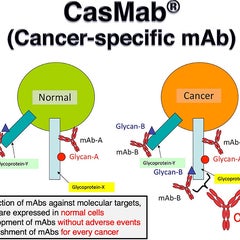EpMab-16の論文がOncology Reportsにアクセプトされました。2020年の37報目です。

Mika K. Kaneko, Tomokazu Ohishi, Junko Takei, Masato Sano, Takuro Nakamura, Hideki Hosono, Miyuki Yanaka, Teizo Asano, Yusuke Sayama, Hiroyuki Harada, Manabu Kawada, Yukinari Kato*
(*corresponding author)
The Anti-EpCAM monoclonal antibody (EpMab-16) exerts anti-tumor activity against oral squamous cell carcinomas
Oncology Reports., in press
Figure legends
Figure 1. Recognition of EpCAM by anti-EpCAM mAbs. CHO/EpCAM, CHO-K1, SAS, and HSC-2 cells were treated with EpMab-16 (1 μg/ml) and buffer control, followed by secondary antibodies.
Figure 2. Western blot analysis using anti-EpCAM mAbs. Cell lysates (10 μg) of CHO-K1, CHO/EpCAM, SAS, and HSC-2 were electrophoresed and transferred onto PVDF membranes. The membranes were incubated with 5 μg/ml of EpMab-16 and 1 μg/ml of anti-b-actin, followed by peroxidase-conjugated anti-mouse immunoglobulins. Red arrow shows EpCAM. Blue arrows show non-specific bands, which were detected in both CHO-K1 and CHO/EpCAM cells.
Figure 3. Immunohistochemical analyses of OSCC tissues using EpMab-16. (A, B) Formalin-fixed, paraffin-embedded (FFPE) tissue sections of OSCC (Case 1) were incubated with 10 μg/ml of EpMab-16. (C, D) Hematoxylin and eosin (H&E) staining against consecutive OSCC tissues (Case 1). (E, F) FFPE tissue sections of OSCC (Case 2) were incubated with 10 μg/ml of EpMab-16. (G, H) H&E staining against consecutive OSCC tissues (Case 2). Scale bar = 100 μm.
Figure 4. Determination of binding affinity of anti-EpCAM mAbs for OSCC cells. (A) The SAS cells were suspended in 100 μl of serially diluted EpMab-16, followed by the addition of Alexa Fluor 488-conjugated anti-mouse IgG, and fluorescence data were collected. (B) HSC-2 cells were suspended in 100 μl of serially diluted EpMab-16, followed by the addition of Alexa Fluor 488-conjugated anti-mouse IgG, and fluorescence data were collected.
Figure 5. ADCC activity of anti-EpCAM mAbs in OSCC cells. (A) ADCC activity of EpMab-16, control mouse IgG2a, and control PBS in SAS cells. (B) ADCC activity of EpMab-16, control mouse IgG2a, and control PBS in HSC-2 cells. Values represent mean ± SEM. Asterisks indicate statistical significance (**P < 0.01, n.s. not significant, by ANOVA and Tukey’s multiple comparisons tests).
Figure 6. CDC activity of anti-EpCAM mAbs in OSCC cells. (A) CDC activity of EpMab-16, control mouse IgG2a, and control PBS in SAS cells. (B) CDC activity of EpMab-16, control mouse IgG2a, and control PBS in HSC-2 cells. Values represent mean ± SEM (standard error of the mean). Asterisks indicate statistical significance (**P < 0.01, n.s. not significant, ANOVA and Tukey’s multiple comparisons tests).
Figure 7. Anti-tumor activity of anti-EpCAM mAbs in SAS xenografts. (A) Tumor volume of SAS xenografts. SAS cells (5 × 106 cells) were injected subcutaneously into the left flank, and 100 µg of EpMab-16 or control mouse IgG in 100 µl PBS was injected i.p. into treatment and control mice, respectively. Additional antibodies were injected on days 8 and 14. Tumor volume was measured on days 7, 10, 14, and 17. Values represent mean ± SEM. Asterisks indicate statistical significance (**P < 0.01, *P < 0.05, n.s. not significant, ANOVA and Sidak’s multiple comparisons tests) (B) Tumor weights of SAS xenografts. Tumors of SAS xenografts were resected from EpMab-16 and control mouse IgG groups. Tumor weight on day 17 was measured from excised xenografts. Values represent mean ± SEM. Asterisks indicate statistical significance (*P < 0.05, Welch’s t-test). (C) Resected tumors of SAS xenografts from EpMab-16 and control mouse IgG groups on day 17. The tumor in the dotted region is the largest tumor in this experiment. The white square grids under the tumors are 1 cm × 1cm each. Scale bar = 1 cm. (D) A magnified image of the largest tumor in the dotted region of Figure 7C. The vertical and horizontal lengths for SAS cells were 24 cm and 13 cm, respectively (estimated tumor volume, 2028 mm3). All mice possess one tumor each.
Figure 8. Anti-tumor activity of anti-EpCAM mAbs in HSC-2 xenografts. (A) Tumor volume of HSC-2 xenografts. HSC-2 cells (5 × 106 cells) were injected subcutaneously into the left flank, and 100 µg of EpMab-16 or control mouse IgG in 100 µl PBS was injected i.p. into treatment and control mice, respectively. Additional antibodies were then injected on days 8 and 14. Tumor volume was measured on days 7, 10, 14, and 18. Values represent mean ± SEM. Asterisks indicate statistical significance (**P < 0.01, n.s. not significant, ANOVA and Sidak’s multiple comparisons tests) (B) Tumor weights of HSC-2 xenografts. Tumors of HSC-2 xenografts were resected from EpMab-16 and control mouse IgG groups. Tumor weight on day 18 was measured from excised xenografts. Values represent mean ± SEM. Asterisks indicate statistical significance (*P < 0.05, Welch’s t-test). (C) Resected tumors of HSC-2 xenografts from EpMab-16 and control mouse IgG groups on day 18. The tumor in the dotted region is the largest tumor in this experiment. The white square grids under the tumors are 1 cm × 1cm each. Scale bar = 1 cm. (D) A magnified image of the largest tumor in the dotted region of Figure 8C. The vertical and horizontal lengths for HSC-2 cells were 18 cm and 12 cm, respectively (estimated tumor volume, 1296 mm3). All mice possess one tumor each.
